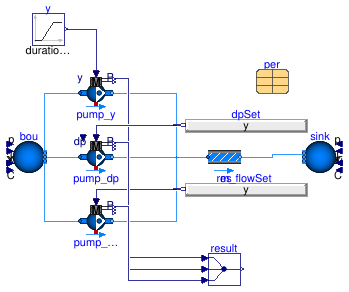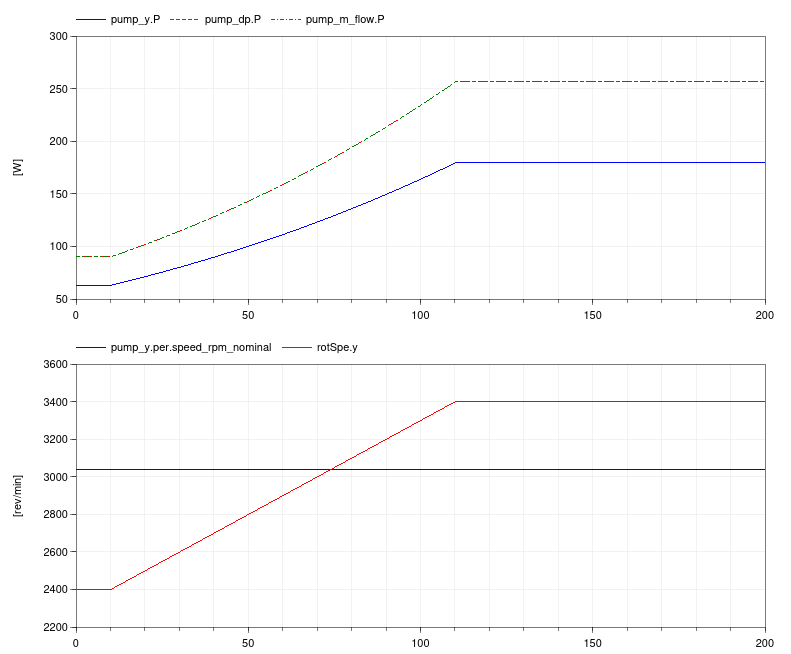Buildings.Obsolete.Fluid.Movers.Validation
Obsolete validation models
Information
This package contains obsolete validation models.
Extends from Modelica.Icons.ExamplesPackage (Icon for packages containing runnable examples).
Package Content
| Name | Description |
|---|---|
| Power calculation comparison among three mover types, using Euler number computation for m_flow and dp | |
| Power calculation comparison among three mover types, using exact power computation for m_flow and dp | |
| Power calculation comparison among three mover types, using simplified power computation for m_flow and dp |
 Buildings.Obsolete.Fluid.Movers.Validation.PowerEuler
Buildings.Obsolete.Fluid.Movers.Validation.PowerEuler
Power calculation comparison among three mover types, using Euler number computation for m_flow and dp

Information
This example is identical to
Buildings.Obsolete.Fluid.Movers.Validation.PowerSimplified,
except that the efficiency of the flow controlled pumps
pump_dp and pump_m_flow
is estimated by using the Euler number and its correlation as implemented in
Buildings.Fluid.Movers.BaseClasses.Euler.
The figure below shows the approximation error for the power calculation where the speed y differs from the nominal speed ynominal.

Extends from Buildings.Obsolete.Fluid.Movers.Validation.PowerSimplified (Power calculation comparison among three mover types, using simplified power computation for m_flow and dp).
Parameters
| Type | Name | Default | Description |
|---|---|---|---|
| MassFlowRate | m_flow_nominal | 3 | Nominal mass flow rate [kg/s] |
| Stratos30slash1to8 | per | Pump performance data | |
| Generic | perPea | perPea(final powerOrEfficien... | Peak condition |
Modelica definition
 Buildings.Obsolete.Fluid.Movers.Validation.PowerExact
Buildings.Obsolete.Fluid.Movers.Validation.PowerExact
Power calculation comparison among three mover types, using exact power computation for m_flow and dp

Information
This example is identical to
Buildings.Obsolete.Fluid.Movers.Validation.PowerSimplified, except that the
performance data for the flow controlled pumps
pump_dp and pump_m_flow contain
the pressure curves and efficiency curves.
The plot below shows that this leads to a computation of the power consumption
that is identical to the one from the speed controlled pump pump_y.

Extends from Buildings.Obsolete.Fluid.Movers.Validation.PowerSimplified (Power calculation comparison among three mover types, using simplified power computation for m_flow and dp).
Parameters
| Type | Name | Default | Description |
|---|---|---|---|
| MassFlowRate | m_flow_nominal | 3 | Nominal mass flow rate [kg/s] |
| Stratos30slash1to8 | per | Pump performance data |
Modelica definition
 Buildings.Obsolete.Fluid.Movers.Validation.PowerSimplified
Buildings.Obsolete.Fluid.Movers.Validation.PowerSimplified
Power calculation comparison among three mover types, using simplified power computation for m_flow and dp

Information
This example compares the power consumed by pumps that take three different control signals. Each pump has identical mass flow rate and pressure rise.
Note that for the instances
Buildings.Fluid.Movers.FlowControlled_dp
and
Buildings.Fluid.Movers.FlowControlled_m_flow,
we had to assign the efficiencies (otherwise the default constant
efficiency of 0.7 would have been used).
In these models, the power consumption is computed
using similarity laws, but using the mass flow rate as opposed
to the speed, because speed is not known in these two models.
This is an approximation at operating points in which
the speed is different from the nominal speed y_nominal
because similarity laws are valid for speed and not for
mass flow rate.
The figure below shows the approximation error for the power calculation where the speed y differs from the nominal speed ynominal.

Extends from Modelica.Icons.Example (Icon for runnable examples).
Parameters
| Type | Name | Default | Description |
|---|---|---|---|
| MassFlowRate | m_flow_nominal | 3 | Nominal mass flow rate [kg/s] |
| Stratos30slash1to8 | per | Pump performance data |
